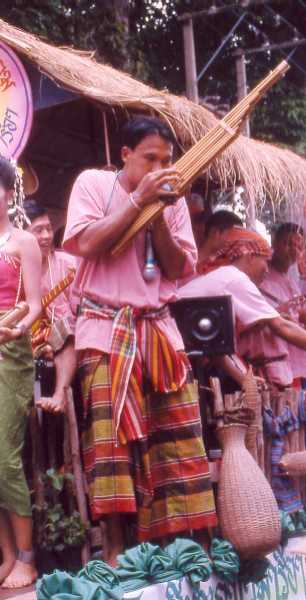|
Ploy (musical Instrument)
The ploy (Khmer: ព្លយខ្មែរ) is a Cambodian wind instrument. It is constructed of a gourd body with 5 to 7 bamboo tubes protruding from the body, and a bamboo pipe set at a right angle to the gourd. Musicians blow air in through the bamboo tube, which fills the gourd "wind chest" and exits through the other bamboo tubes. Each of the bamboo sound-tubes has a metal rod inside, that vibrate in the air passing through the tube. As well as blowing air out of the instrument, the musician can also suck air in, producing a different tone. Notes are produced by covering and uncovering holes cut into the bamboo sound-tubes. The instrument is primarily rural, found mainly Mondulkiri Province among the Phnoung and Tampuan peoples. The instrument may be related to a Laotian instrument, the khaen. Distant origins and relations According to music historian Curt Sachs, the Chinese sheng was originally made with a gourd. Over time the gourd was designed out of the Chinese i ... [...More Info...] [...Related Items...] OR: [Wikipedia] [Google] [Baidu] |
Ploy , a Cambodian musical instrument
*PLOY (musical artist),a metal core band from Philadelphia
{{disambiguation ...
A ploy is a tactic (method), strategy, or gimmick. Ploy may also refer to: * Ploy (board game), a board game * ''ploy'' (film), a 2007 Thai film *Ploy (musical instrument) The ploy (Khmer: ព្លយខ្មែរ) is a Cambodian wind instrument. It is constructed of a gourd body with 5 to 7 bamboo tubes protruding from the body, and a bamboo pipe set at a right angle to the gourd. Musicians blow air in through ... [...More Info...] [...Related Items...] OR: [Wikipedia] [Google] [Baidu] |
Pnong People
The Bunong (alternatively Phnong, Punong, or Pnong)Smith, P. (2010). ''The Bunong Culture of Silence: Exploring Bunong perspectives on participation at the interface between Bunong culture and development organisations.'' is an indigenous ethnic group in Cambodia. They are found primarily in Mondulkiri and Ratanakiri in Cambodia. The Bunong is the largest indigenous highland ethnic group in Cambodia. They have their language called Bunong, which belongs to Bahnaric branch of Austroasiatic languages. The majority of Bunong people are animists, but a minority of them follows Christianity (Evangelical Protestantism or Roman Catholicism) and Theravada Buddhism. After Cambodia's independence in 1953, Prince Sihanouk created a novel terminology, referring to the country's highland inhabitants, including the Bunong, as Khmer Loeu ("upland Khmer"). Under the People's Republic of Kampuchea (1979-89), the generic term ជនជាតិភាគតិច (''chuncheat pheaktech'') "et ... [...More Info...] [...Related Items...] OR: [Wikipedia] [Google] [Baidu] |
Tampuan People
The Tampuan (also spelled ''Tompuan'”Tompoun” or “Om Poun” called in their own language or ''Tampuon'', ''Tumpoun', ) are an indigenous ethnic group living in northeast Cambodia. Numbering about 31,000, the Tampuan people live in the mountainous Southern and Western portions of the Cambodian province of Ratanakiri. They have their own language of the Mon–Khmer language family. Tampuans, along with the other Mon-Khmer groups of the mountains, are referred to as Khmer Loeu ("Upper Khmer") by the Khmer majority. In English, montagnards, a designation given to all hill tribes in the former French Indochina is often used. Though historically their language has been without a writing system, in the last ten years an NGO has overseen the creation of a writing system, based on the Cambodian alphabet. However, fewer than 80% of Tampuans are literate. Culture The Tampuan people are a mountain people, living in communal villages that range from 100 to 400 inhabi ... [...More Info...] [...Related Items...] OR: [Wikipedia] [Google] [Baidu] |
Kaen
The ''khaen'' (; spelled "Khaen", "Kaen", "Kehn" or "Ken" in English; , ; , , ; , ; – ''Ken''; Vietnamese: ''khèn'' or ''kheng'') is a Lao mouth organ whose pipes, which are usually made of bamboo, are connected with a small, hollowed-out hardwood reservoir into which air is blown. The khaen is the national instrument of Laos. The khene music is an integral part of Lao life that promotes family and social cohesion and it was inscribed in 2017 on the UNESCO Representative List of the Intangible Cultural Heritage of Humanity''.'' It is used among the ethnic Lao Isan and Some tai ethnic groups such as Tai dam In north Vietnam and Lao population of the province of Stung Treng and is used in ''lakhon ken'', a Cambodian dance drama genre that features the ''khaen'' as the main instrument In Vietnam, this instrument is used among the Tai peoples and the Muong people. The khaen uses a free reed made of brass and/or silver. It is related to Western free-reed instruments such as the ha ... [...More Info...] [...Related Items...] OR: [Wikipedia] [Google] [Baidu] |
Sheng (instrument)
The ( zh, c=笙) is a Chinese mouth-blown polyphonic free reed instrument consisting of vertical pipes. It is one of the oldest Chinese instruments, with images depicting its kind dating back to 1100 BCE, and there are original instruments from the Han dynasty that are preserved in museums today. Traditionally, the has been used as an accompaniment instrument for solo or performances. It is one of the main instruments in and some other forms of Chinese opera. Traditional small ensembles also make use of the , such as the wind and percussion ensembles in northern China. In the modern large Chinese orchestra, it is used for both melody and accompaniment. The has been used in the works of a few non-Chinese composers, including Unsuk Chin, Jukka Tiensuu, Lou Harrison, Tim Risher, Daníel Bjarnason, Guus Janssen and Christopher Adler. Some believe that Johann Wilde and Pere Amiot traveled to China and brought the first to Europe in 1740 and 1777 respectively, altho ... [...More Info...] [...Related Items...] OR: [Wikipedia] [Google] [Baidu] |




